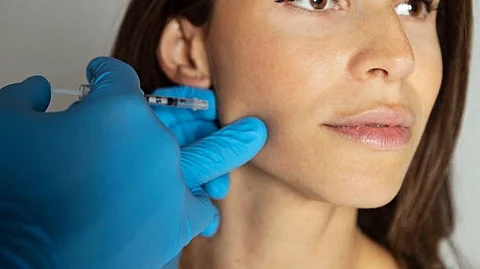Possible Side Effects of Masseter Botox
Masseter Botox is widely considered safe and effective, but like any medical procedure, it may come with a few side effects. Knowing what to expect can help you make a confident, informed decision.
Mild Swelling or Discoloration
After the injection, you might notice slight bruising, redness, or swelling around the treated area. This is normal and usually fades within a few days. Some people may also feel tightness in their jaw or notice a minor change in their bite during the initial days.
Temporary Muscle Weakness
Because Botox works by relaxing the masseter muscles, you may temporarily find it harder to chew tough or crunchy foods. This effect is typically short lived and improves as your muscles adjust.
Subtle Changes in Facial Expression
In rare cases, if Botox spreads beyond the intended area, it may affect nearby muscles. This can lead to slight asymmetry or changes in facial expressions, but with a skilled provider, this risk is minimal.
Allergic Reactions
Though extremely rare, allergic reactions can happen. Watch out for signs like itching, hives, difficulty breathing, dizziness, or fainting. Seek medical help immediately if you notice any of these symptoms.
Jaw Muscle Shrinkage (Atrophy)
Over time and with repeated treatments, some people may experience a slimming effect or reduced muscle mass in the jaw. While this is usually subtle and even desired in some cases, it’s something to consider if you’re planning on long-term use. (3)
Final Thoughts
Masseter Botox is a minimally invasive and effective treatment option for people dealing with jaw tension, teeth grinding, or who want to achieve a more sculpted facial shape. Just be sure to consult with a qualified provider experienced in facial aesthetics to ensure safe and effective treatment.
References:
“Bruxism (Teeth Grinding)”, Cleveland Clinic, Last modified on December 18, 2023, https://my.clevelandclinic.org/health/diseases/10955-teeth-grinding-bruxism#overview
Kirsten Nunez, “All about Masseter Botox”, Healthline, Last modified on January 7, 2021. https://www.healthline.com/health/masseter-botox
Peter Peng, Hsien-Li. “Masseter Hypertrophy: Toxin Treatment Techniques, Causes of Complications, and Prevention’” IntechOpen, November 5, 2018, doi:10.5772/intechopen.79616. https://www.intechopen.com/chapters/62650


